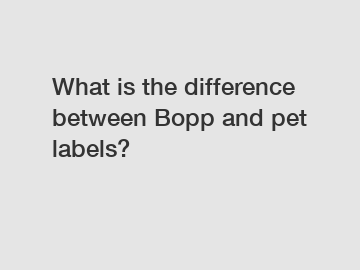When it comes to labeling products, businesses have a variety of options to choose from. Two popular choices in the industry are BOPP and PET labels. While these labels may seem similar at first glance, there are some key differences between the two that can make a big impact on the final product. In this blog post, we will explore the differences between BOPP and PET labels and discuss the advantages of each.
BOPP, which stands for biaxially-oriented polypropylene, is a type of plastic film that is commonly used for labeling products. BOPP labels are known for their high clarity, excellent print quality, and moisture resistance. These labels are often used in food and beverage packaging, as well as personal care products.
PET, or polyethylene terephthalate, is another type of plastic film that is used for labeling products. PET labels are known for their durability, resistance to tearing, and ability to withstand high temperatures. These labels are often used in industrial applications, as well as in the labeling of electronics and appliances.

One of the key differences between BOPP and PET labels is their level of transparency. BOPP labels are known for their high clarity, which makes them ideal for products that require a clear label to showcase the contents inside. PET labels, on the other hand, are less transparent and are often used for products where opacity is preferred.
Another key difference between BOPP and PET labels is their level of durability. BOPP labels are known for their moisture resistance, making them ideal for products that may come into contact with water or other liquids. PET labels, on the other hand, are known for their durability and resistance to tearing, making them ideal for products that require a label that can withstand rough handling.
In addition to their differences in transparency and durability, BOPP and PET labels also differ in their environmental impact. BOPP labels are recyclable, making them a more sustainable option for businesses looking to reduce their carbon footprint. PET labels, on the other hand, are not as easily recyclable and may have a larger environmental impact.
When it comes to choosing between BOPP and PET labels, there are a few key factors to consider. If transparency is important for your product, BOPP labels may be the best choice. If durability and tear resistance are more important, PET labels may be the better option. Additionally, if environmental sustainability is a priority for your business, BOPP labels may be the more eco-friendly choice.
In conclusion, both BOPP and PET labels have their own unique advantages and disadvantages. Ultimately, the decision between the two will depend on the specific needs of your product and your business. By considering factors such as transparency, durability, and environmental impact, you can make an informed decision that will help your products stand out on the shelves and appeal to consumers. Whether you choose BOPP or PET labels, you can rest assured that both options will provide a high-quality and professional finish for your products.
For more bopp definition, bopp bi oriented polypropylene, aluminized polyester filminformation, please contact us. We will provide professional answers.



Comments
Please Join Us to post.
0